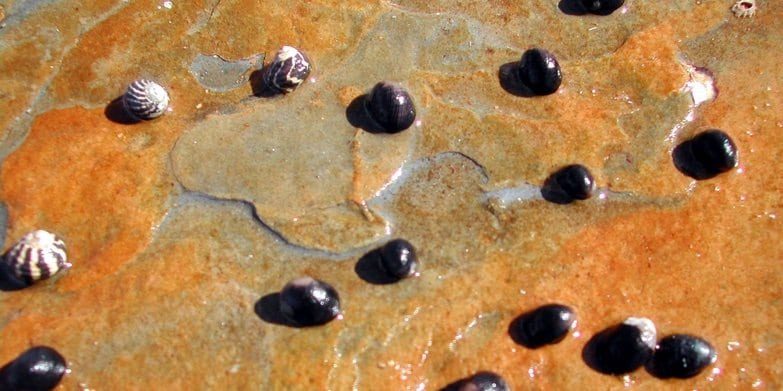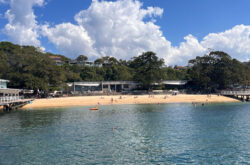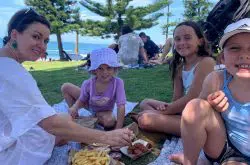Rock pools near the North Shore offer the chance to explore a colourful underwater world, teeming with sea creatures! Here’s some popular tidal pools to visit, plus some info on all the fascinating sea creatures you might come across. Dr Roberts is a GP, but decided she wanted to get more knowledgeable about all the critters she and her kids were discovering. Here’s what she’s discovered.
This summer, I was poking around rock platforms at the beach with my kids, as I’m sure many of you have been doing! And in every pool, the kids would point to some slimy item with great fascination and chirp, ‘What’s this, Mumma?’ My deeply unsatisfying reply was, ‘Um,’ as none of them were human body parts or diseases (which I know all about from my work as a doctor).
I promised to look it all up once we got back into internet range, and went back to giving resentful sideways glances to rested-looking twenty-somethings lying on circular beach towels, drinking coffee casually as though they don’t even need it to live, and reading actual books.
My own dad is one of those people who can stroll about naming plants and trees by their common and Latin names, so I decided I would take a leaf out of Grandpa’s book (see what I did there?) and get to know a few of the creatures of the rock pools of the NSW coast.
Rock pools near the North Shore: Our favourite tidal pools
Firstly, let’s talk location. Some good spots near the north shore to visit tidal rock pools include:
-
Queenscliff Beach and Rock Pool, Manly
-
Freshwater Rock Pool, Freshwater
-
Dee Why Rock Pool, Oaks Avenue, Dee Why
-
Clovelly Beach, Clovelly
-
Bogey Hole and Rockpool, Bronte
Click here to view the full list and details.
Rock Pools near the North Shore: Creatures to spot
What follows below is a little bit of what I found interesting about six of the most common inhabitants of rock pools along the Sydney coastline.
1. Zebra Snail (Austrocochlea Porcata)
This little guy is ubiquitous around the NSW coast, and has a delightful common name: the zebra snail. In Latin, his name is a little nerdier: it translates to ‘southern broad-ridged spiral shell’ because the ridges on his shell are wider than the furrows in between; that’s what porcata means. Those of you who speak Italian will be able to draw a line between this fact, and the word’s meaning in that language. (I’ll leave the rest of you to Google Translate that one for yourselves. Hint: it’s a bit rude.)
Anyway, the common name is easy to remember because, well, look at him! He looks like a little zebra. He eats algae, and fascinatingly, at certain times of the year the algae he eats contains a substance that moves into his shell to form black stripes rather than white ones. He comes from the family of sea snails known as Trochidae or ‘top snails’, because they look like spinning tops. Cute, huh?
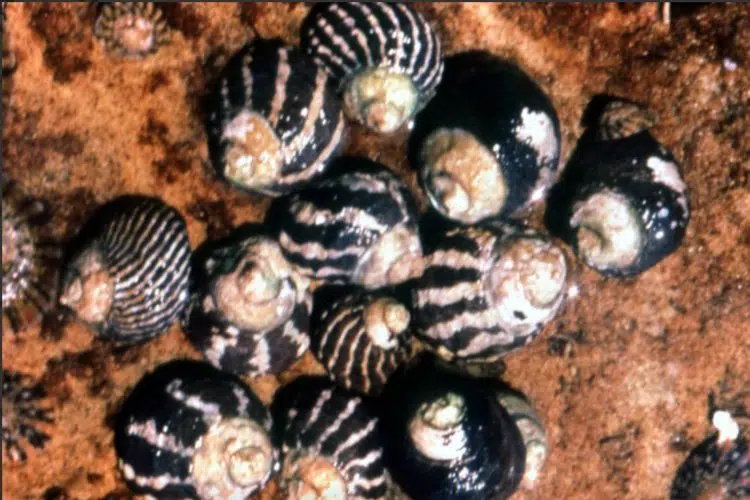
2. Turban Snail or Common Warner (Turbo undulata)
It wasn’t until I started researching this article that I realised the brilliance of the title of the 2013 Dreamworks film Turbo, about a plucky little snail who wants to race against stock cars. Turbo is the name of the genus of many snails, because it refers to something that turns, like the spiral of the snail’s shell. This sea snail is no exception, and the common name derives from their resemblance to a turban. Undulata describes the wavy shape of part of the spiral.
Now, would you like to know something extremely nerdy about this snail? She differs from the zebra snail and his pals because she has a hard, bony little trapdoor covering the underside of her shell where the body of the snail is, whereas the zebra snail has a softer door. These doors are called operculae (from the Latin ‘to close’) and are often also seen washed up on beaches: white, flat little spiral discs, completely separate to the snail once it dies.

3. Neptune’s Necklace (Hormosira Banksii)
Algae and plants are similar, in that they both ‘make their food from the rays of the sun’ (sing with me!) i.e. they photosynthesise, but plants are more complex in structure than algae. Neptune’s necklace is an algae, and is made up of chains of little air-filled beads or pneumocysts. It is widespread in tidal pools thanks to a slimy coating which makes it very resistant to drying in the sun when the tide goes out. Fortunately too, since the kids seem to love pulling the ‘beads’ apart while my back is turned, I discovered that it is capable of reproducing itself from ‘detached fragments’ (phew). Yep, this one’s a survivor, and it provides a lovely habitat for other creatures.
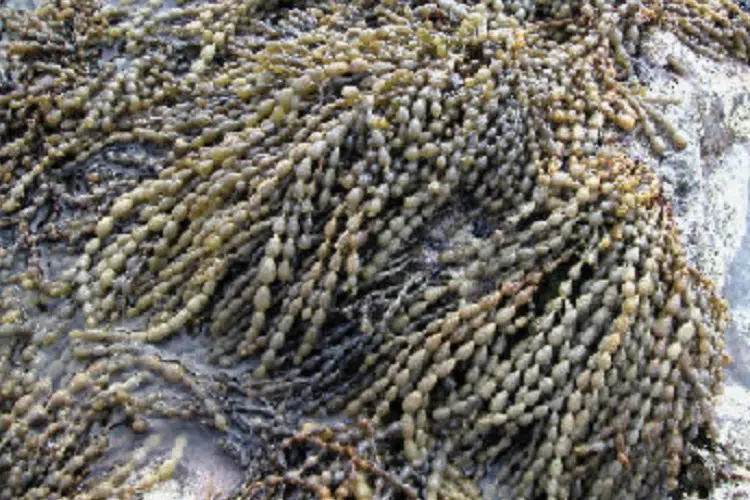
4. Purple Sea Urchin (Heliocidaris Erythrogramma)
Helios is the sun in Greek mythology, and erythrogramma refers to their red eggs or roe (erythro = red and gram = grain/seed). These urchins are common in Australia but also in Japan, where they are a delicacy. Apparently, ‘urchin’ is an old word for hedgehog, and sea urchins used to be known as sea hedgehogs, which is a bit cute.
Sea urchins are truly ancient creatures, twice as old as the dinosaurs, and they have survived so long by keeping things simple. They have a hard, mandarin-shaped shell called a test, which has a mouth on the bottom and a bottom on the top, so to speak. Rather like a mandarin, they have five internal segments which are identical. They move slowly by pumping water in and out of little tube ‘feet’. They eat algae, but their mouths and teeth are so good at crunching up rocks that a group of engineers at the University of California at San Diego used them as a model to create a claw to scoop up soil on other planets. Their spines are attached to the shell by little ball and socket joints, rather like our shoulder or hip joints, so they can point in all directions. This little spiky sea ball can even detect light, touch and certain chemicals. Little spiky sea amaze-ball, more like.

5. Waratah Anemone (Actinia Tenebrosa)
The waratah anemone deserves a mention here because it is named after the NSW floral emblem, and it’s easy to see why. It is only red when it is under water and open; when the tide is out it inverts into a little brownish slimy dome, and it’s a good job it wasn’t named for how it looks in this state. Sea anemones are named after the anemone flower but they are animals, most closely related to coral and jellyfish. Their Latin name (‘dark ray/sun’) reflects the fact that their colour darkens depending on the amount of sunlight they receive, and I suppose they also look like dark red suns.
Like flowers, sea anemones appear to be rooted to the spot, but they are actually capable of glacially slow movement and can be quite vicious. They will attack and eat neighbouring anemones if they are not from the same family. They have stinging tentacles which they use to catch prey, which they then deliver into their central mouth. They breed live young, and when they reach maturity the young are kicked out of the anemone’s mouth, or else they can reproduce by breaking a little chip off the old block and letting a piece of their body form a new anemone nearby. I give these things 10 out of 10 marks for weirdness.

6. Black Nerite (Nerita Melanotragus)
Nerites was a junior sea god in Greek mythology. He was the original manchild who wouldn’t leave home, despite having fifty sisters, and not even when he got a girlfriend – Aphrodite, Goddess of Love no less. She asked him to move out to Olympus with her and offered him a pair of wings to sweeten the deal, but he refused, preferring to stay in the sea with his parents Nereus and Doris (stop doing all his washing for him, Nereus and Doris). So Aphrodite gave the wings to her son Eros, from a previous relationship (yeah, it’s complicated), and turned Nerites into a shellfish. Hell hath no fury, amirite ladies?
Anyway, the operculum or trapdoor over this snail’s soft parts looks like a black ear, which is what melanotragus means in Latin. The tragus is the soft flap that covers the entrance to your ear canal. Like the other snails, he eats algae which he scrapes from the side of rocks with his one or two teeth. When babies hatch, they live on the back of the adult snail’s shell for about 4 months. Nawww, babywearing. (Get your own place, Nerites!)

A note about rock pool safety:
Mooching around rock pools with kids is a great and free activity for autumn and winter around Sydney (well, it’s free except for the parking). But be aware! There are risks involved…
- Don’t forget to always keep an eye on the water, and never venture onto rock platforms in heavy surf.
- Teach your kids to keep their hands and feet out of rock pools at all times (some of the residents can be slightly deadly).
- Wear sensible footwear. Cuts and scratches and marine-y things stuck in feet have a tendency to get infected with some very interesting germs.
- Slip, Slop, Slap!
Images courtesy: Dr Isobel Bennett/Australian Museum

